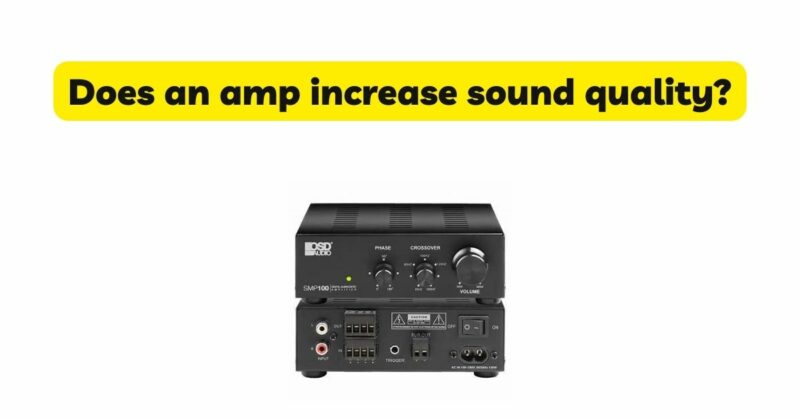When it comes to audio equipment, amplifiers play a critical role in powering speakers and enhancing audio signals. Many audio enthusiasts and consumers believe that investing in a high-quality amplifier will automatically improve the sound quality of their audio systems. However, the question remains: Does an amplifier truly increase sound quality, or is it just a popular misconception? In this article, we will delve into the subject to explore the relationship between amplifiers and sound quality, examining both the technical aspects and the subjective experiences associated with amplifier upgrades.
I. The Role of Amplifiers in Audio Systems:
To understand the impact of amplifiers on sound quality, we must first grasp their primary function within an audio system. An amplifier receives an electrical signal from a source such as a CD player or a turntable and boosts its power to drive speakers. The amplification process is crucial in ensuring that the audio signal reaches the speakers with sufficient voltage and current to produce sound at the desired volume. Without amplifiers, audio signals would remain weak and undetectable by human ears.
II. Power and Headroom:
One of the key benefits of a high-quality amplifier lies in its ability to deliver ample power and headroom. Power, measured in watts, determines the amplifier’s ability to drive speakers and reproduce dynamic and demanding audio passages accurately. Headroom refers to the extra power reserve available beyond the normal listening levels, allowing the amplifier to effortlessly handle sudden peaks and transients in music. A low-quality or underpowered amplifier may struggle to provide sufficient power and headroom, resulting in distortion, clipping, and compromised sound quality.
III. Signal-to-Noise Ratio (SNR) and Distortion:
Two essential factors affecting sound quality are the signal-to-noise ratio (SNR) and distortion. SNR quantifies the ratio between the desired audio signal and unwanted background noise introduced during the amplification process. A higher SNR indicates less audible noise and a cleaner audio signal. Similarly, distortion measures the level of signal alteration introduced by the amplifier. Low-quality amplifiers may exhibit higher levels of distortion, resulting in muddier sound reproduction. Upgrading to a better amplifier with improved SNR and lower distortion can enhance sound clarity and fidelity.
IV. Frequency Response and Impedance Matching:
Frequency response refers to an amplifier’s ability to reproduce audio across the entire audible frequency range. An ideal amplifier should have a flat frequency response, ensuring that all frequencies are reproduced accurately without excessive emphasis or attenuation. A high-quality amplifier can offer better frequency response, contributing to improved tonal balance and more accurate sound reproduction. Additionally, matching the amplifier’s impedance to the speaker’s impedance can optimize power transfer and minimize distortion, further enhancing sound quality.
V. Subjective Listening Experience:
While technical specifications provide a scientific basis for assessing amplifier performance, the subjective listening experience remains paramount. The human ear is highly sensitive to nuances in sound, and personal preferences and perceptions play a significant role in determining sound quality. Upgrading to a higher-quality amplifier can result in subtle improvements that audiophiles and discerning listeners might appreciate, such as tighter bass response, improved spatial imaging, and better instrument separation. However, the extent of these improvements may vary among individuals and depend on factors such as the rest of the audio chain, listening environment, and familiarity with high-fidelity audio.
VI. System Synergy and Balance:
It is crucial to consider the overall synergy and balance of the audio system when evaluating the impact of an amplifier on sound quality. Audio systems are complex ecosystems, consisting of various components like speakers, source devices, cables, and room acoustics. Each component interacts with the others, and the overall performance is influenced by the weakest link in the chain. While a high-quality amplifier can undoubtedly contribute to improved sound quality, it is equally important to ensure that the other components in the system are of comparable quality and properly optimized for optimal performance.
VII. Budget Considerations:
It is important to note that the price tag of an amplifier does not always equate to superior sound quality. Expensive amplifiers may offer additional features, build quality, and brand reputation, but they may not necessarily provide a substantial improvement in sound fidelity compared to more reasonably priced options. It is advisable to allocate a budget that strikes a balance between performance and affordability, taking into account personal preferences and the specific needs of the audio system.
Conclusion:
While it is true that a better amplifier can potentially improve sound quality in an audio system, the degree of improvement and its perceptibility vary among individuals. Technical factors such as power, SNR, distortion, frequency response, and impedance matching all contribute to the overall performance of an amplifier. However, the subjective listening experience and the synergy with other components in the system also play crucial roles in determining the perceived sound quality. Ultimately, it is important to strike a balance between technical specifications, personal preferences, and budget considerations when deciding whether to upgrade an amplifier for an improved audio experience.


